Hypertrophy training targets muscle growth by using moderate weights and higher repetitions to maximize muscle size, while strength training focuses on lifting heavier weights with lower repetitions to increase overall power. Both methods improve muscle function but differ in their impact on muscle endurance and metabolic health. Choosing between hypertrophy and strength training depends on individual health goals and pet-specific needs for mobility and injury prevention.
Table of Comparison
| Aspect | Hypertrophy Training | Strength Training |
|---|---|---|
| Goal | Increase muscle size | Maximize muscle strength |
| Repetitions | 6-12 reps per set | 1-5 reps per set |
| Sets | 3-6 sets | 3-5 sets |
| Rest Period | 30-90 seconds | 2-5 minutes |
| Load Intensity | 65-85% of 1RM | 85-100% of 1RM |
| Training Focus | Muscle hypertrophy and volume | Neural adaptations and maximal force |
| Exercise Type | Isolation and compound lifts | Primarily compound lifts |
| Benefits | Muscle growth, improved physique | Increased power, improved athletic performance |
Understanding Hypertrophy Training
Hypertrophy training targets muscle fiber growth by emphasizing moderate to high repetitions (6-12 reps) with moderate weights and shorter rest periods to maximize muscle fatigue and metabolic stress. This form of training stimulates muscle protein synthesis through muscle damage and cellular swelling, which are key factors for increasing muscle size over time. Understanding hypertrophy training requires recognizing its goal to enhance muscle volume rather than purely increasing maximal strength output.
What is Strength Training?
Strength training involves exercises designed to increase the maximum force a muscle or group of muscles can generate, typically using heavy weights with low repetitions. It primarily targets neural adaptations, enhancing muscle fiber recruitment and improving overall power and muscle coordination. Common methods include lifting free weights, resistance machines, and bodyweight exercises aimed at boosting muscular strength rather than muscle size.
Key Differences Between Hypertrophy and Strength Training
Hypertrophy training primarily targets muscle size by emphasizing moderate to high volume and moderate loads, typically involving 6-12 reps per set with shorter rest periods to maximize metabolic stress and muscle damage. Strength training focuses on increasing maximal force output, utilizing heavier loads with lower repetitions, usually 1-6 reps per set, and longer rest intervals for optimal neural adaptations. The key differences lie in training goals, load intensity, volume, repetition range, and rest duration, which directly impact muscle fiber recruitment and overall performance adaptations.
Muscle Growth vs. Power Development
Hypertrophy training primarily targets muscle growth by increasing muscle fiber size through moderate weights and higher repetitions, typically in the range of 6-12 reps per set. Strength training emphasizes power development by lifting heavier weights at lower repetitions, usually between 1-5 reps per set, which enhances neural adaptations and maximal force output. Both training types contribute to muscle development but differ in their focus on cellular muscle enlargement versus neuromuscular efficiency.
Training Methods and Repetition Ranges
Hypertrophy training typically involves moderate to high repetition ranges, usually between 6 to 12 reps per set, emphasizing muscle fatigue and metabolic stress to stimulate muscle growth. Strength training prioritizes lower repetition ranges, generally 1 to 5 reps per set, with heavier loads to enhance maximal force production and neural adaptations. Both training methods utilize progressive overload but differ in tempo, rest intervals, and volume to target muscle size versus maximal strength development.
Health Benefits of Hypertrophy Training
Hypertrophy training enhances muscle size by increasing the cross-sectional area of muscle fibers, which supports joint stability and reduces injury risk. This type of training improves metabolic health by boosting basal metabolic rate and insulin sensitivity, aiding in weight management and diabetes prevention. Furthermore, hypertrophy training promotes better cardiovascular health through increased muscle mass that supports efficient blood circulation and oxygen utilization.
Health Benefits of Strength Training
Strength training enhances muscle mass, bone density, and metabolic rate, reducing the risk of osteoporosis and type 2 diabetes. It improves cardiovascular health by lowering blood pressure and promoting better lipid profiles. Regular strength training also boosts mental health by decreasing symptoms of anxiety and depression through increased endorphin levels.
Choosing the Right Training for Your Goals
Hypertrophy training emphasizes muscle size growth through moderate weight and higher repetitions, ideal for bodybuilders or those seeking aesthetic improvement. Strength training targets maximal force production using heavier weights and lower repetitions, suited for athletes aiming to increase power and functional performance. Selecting the right training depends on whether your primary goal is muscle mass enhancement or improved strength capacity.
Common Myths About Hypertrophy and Strength Training
Hypertrophy training is often misunderstood as purely for muscle size, neglecting its role in enhancing muscular endurance and metabolic health. Strength training myths include the misconception that it invariably leads to bulky muscles, ignoring its benefits in improving neuromuscular efficiency and bone density. Both training types contribute uniquely to fitness, debunking the myth that one is superior or exclusive in achieving overall health and performance goals.
Tips for Safe and Effective Progress
Progress in hypertrophy training relies on moderate weights with higher repetitions, promoting muscle growth through metabolic stress and muscle fatigue. Strength training emphasizes lifting heavier weights with lower repetitions to maximize neuromuscular adaptation and increase maximal force output. Prioritize proper form, incorporate progressive overload, and allow ample recovery to prevent injuries and ensure consistent improvement in both training modalities.
Hypertrophy Training vs Strength Training Infographic

 difterm.com
difterm.com